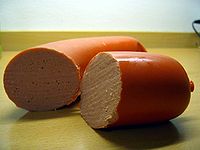Falukorv: Difference between revisions
Moe Epsilon (talk | contribs) m Reverted edit(s) by Mysterywedge identified as test/vandalism using STiki. |
rvv |
||
| Line 1: | Line 1: | ||
[[Image: |
[[Image:Falukorv.jpg|thumb|200px|Falukorv]] |
||
'''Falukorv''' is a large traditional [[Sweden|Swedish]] [[sausage]] made of a grated mixture of pork and beef or veal with [[potato starch flour]] and mild spices. |
'''Falukorv''' is a large traditional [[Sweden|Swedish]] [[sausage]] made of a grated mixture of pork and beef or veal with [[potato starch flour]] and mild spices. |
||
Revision as of 12:13, 17 October 2012

Falukorv is a large traditional Swedish sausage made of a grated mixture of pork and beef or veal with potato starch flour and mild spices.
History
The history of Falukorv reaches back to the Falun copper mine during the 16th and 17th centuries, where ox hide was used for ropes and some of the meat remaining after slaughter was used for sausages. The sausage was based on the Lyoner sausage; the recipe, in which the meat is smoked and salted, was probably brought to the region by Germans working in the mine. [citation needed]
The tradition of preparing the meat in this way was revitalised in the late 19th century by the butcher Anders Olsson, whose initiative led to the development of the modern Falukorv, which uses a mixture of pork and beef or veal. Falukorv has enjoyed high popularity since then.
The designation Falukorv received protection in Sweden in 1973.
In the EU
In the EU, restrictions apply to what may be labeled "Falukorv" since 2001. Only potato flour may be used as a binding agent, and the amount of meat may not fall short of 40%.
Falukorv has TSG Status.
Typical falukorv meals
- Sliced and fried with boiled, fried or mashed potato
- Sliced and fried with elbow macaroni
- Sliced and fried, served with baked Swedish brown beans and fried egg
- Gratinated whole in the oven with cheese and mustard with mashed potatoes
- Substitute for beef in Beef Stroganoff (is then called korvstroganoff which means "sausage stroganoff")

